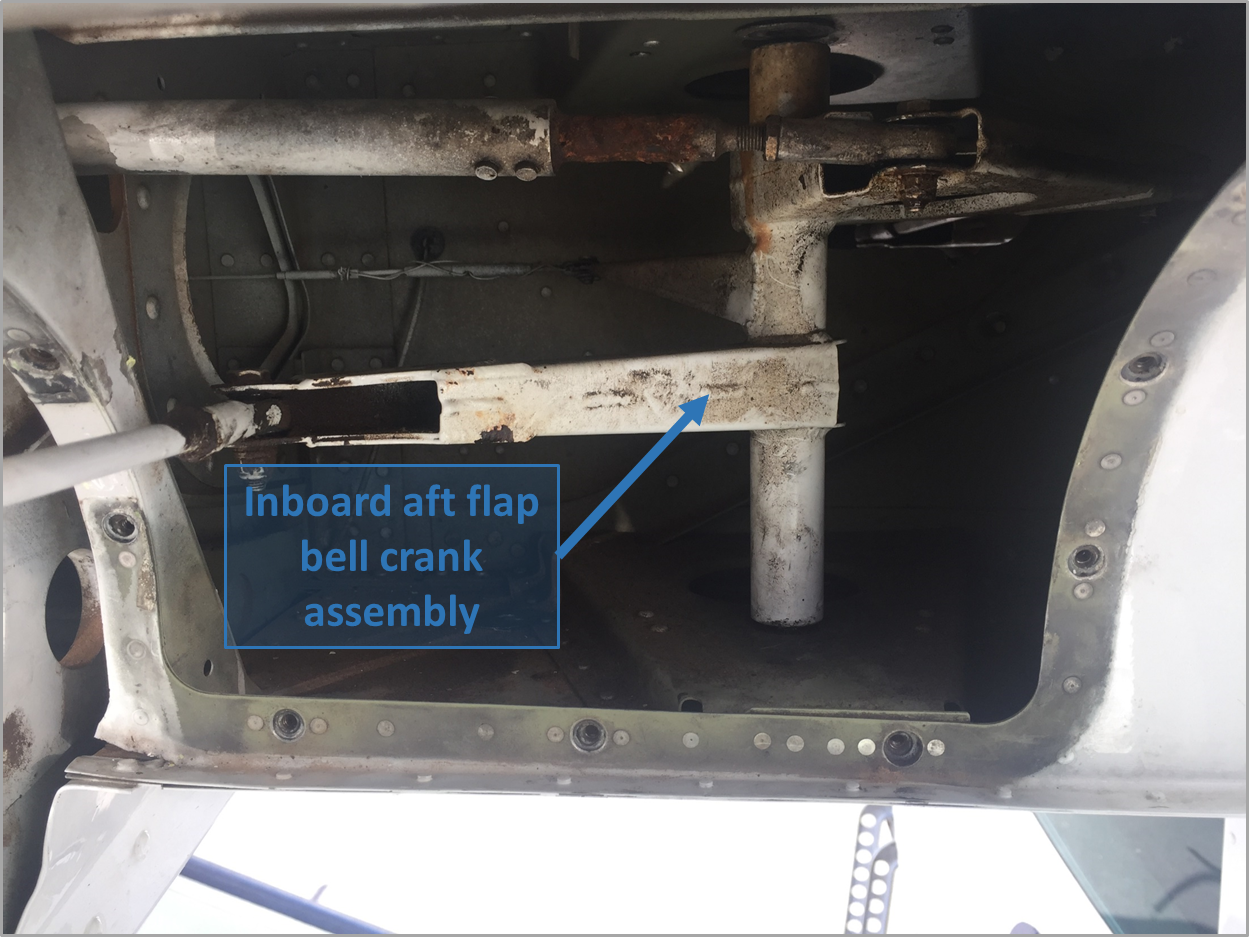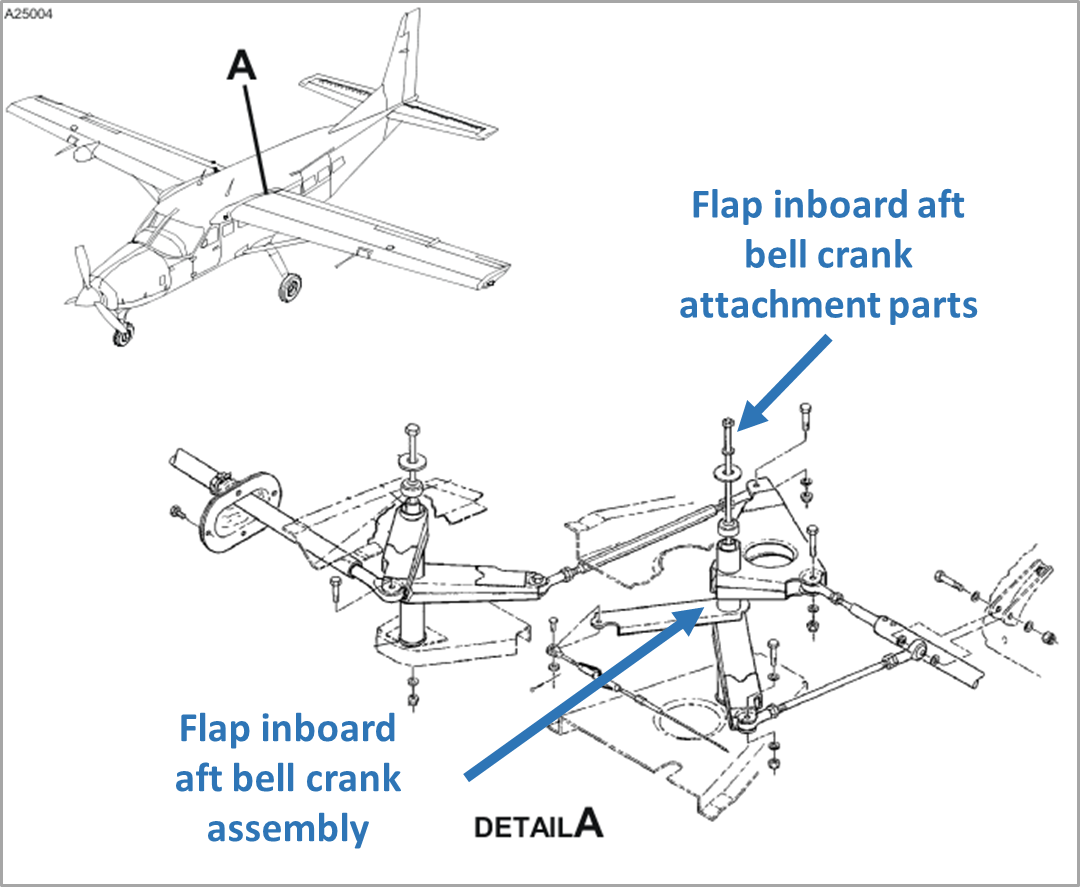What happened
On 10 November 2015, at 1200 Eastern Standard Time (EST), a Cessna 208B aircraft, operated as regular public transport Flight 525 by West Wing Aviation, departed Palm Island Airport for Townsville Airport, Queensland. On board were the pilot and eight passengers.
At about 1250 pm, as the aircraft neared Townsville in instrument meteorological conditions (IMC)[1], air traffic control (ATC) issued the pilot with a runway 07 area navigation (RNAV) instrument approach. The pilot configured the aircraft, and commenced the instrument approach. The pilot reported that approaching the final approach fix,[2] the aircraft was configured with the second stage (20°) of flap, and a power setting of about 1200 ft/lb of torque, resulting in an airspeed of about 125 kt.
Shortly after, at about 1,000 ft above ground level (AGL), the pilot broke visual,[3] and selected the third stage of flap (30°) in preparation for landing. However, this selection of flap resulted in a ‘muffled bang’ from outside the aircraft, which the pilot described as sounding like a tyre blow out. The pilot also reported that the aircraft banked ‘violently’ and steeply to the left.
The pilot immediately attempted to reduce the steep angle of bank and regain control by applying opposite (right) aileron. However, the aircraft continued to roll left, with the subsequent secondary aerodynamic effect of yaw to the left.[4] Descending through about 700 ft, and with the aircraft now travelling at about a 45° angle left of the extended runway centreline and still not responding, the pilot applied full opposite rudder. There was some response from the aircraft to this control input, but the pilot reported it was still not ‘under control’.
The pilot immediately retracted the flaps from 30° to 20°, which resulted in them being able to reduce the angle of bank and regain partial control. The pilot alerted ATC that assistance on the ground might be required after landing.
During this sequence of events, the aircraft had travelled so far off course that the pilot was unable to see the runway even though the aircraft remained in visual conditions. The pilot was able to manoeuvre the aircraft onto an oblique approach and land without further incident. Emergency services followed the aircraft as it was taxied clear of the runway to parking. There were no injuries to those on board, and no damage to the aircraft.
Pre-flight and pre-take-off checks
The pilot reported conducting a thorough daily inspection prior to the first flight of the day. This included fully extending the flaps to check all the eyelets, rods and flap travel. During the pre-take-off checks, the pilot also individually checked each stage of flap to check for correct operation. There were no abnormalities.
Initial post-incident inspection
During the taxi to parking, the pilot fully retracted the flaps. With the flaps flush against the trailing edge of the wing, initially, neither the pilot nor the aircraft maintenance engineer could pinpoint the reason for the control issue. However, when the engineer gave the left flap a shake, it fell freely down, unattached on the inboard side. After removing some wing access panels, the engineering inspection discovered a loose flap bell crank retaining bolt.
The Cessna 208B Flap System
The operator provided the following information (modified by the ATSB).
The Cessna 208B flap system is comprised of both mechanical and electrical components. The cockpit flap control selection lever, operated by the pilot, provides input to the flap switch actuator, which controls the primary flap motor. Allowing the pilot to select any flap position between 0 and 30 degrees, with detents at UP, 10, 20 and FULL down settings. The flap actuator assembly drives a bell crank, through a series of pushrods, connecting rods, interconnecting rods, and other bell cranks.
In the event that the primary flap system fails, there is an independent standby switch and motor.
Figure 1: VH-WZJ inboard aft flap bell crank assembly

Source: Operator, modified by the ATSB
Operator report
The operator conducted both a ‘hard / overweight landing’ inspection and a ‘severe air turbulence or severe manoeuvres’ inspection after the incident. The operator also sought maintenance guidance from the aircraft manufacturer.
The operator advised that a flap bolt had come loose allowing the lower part of the rear aft bell crank to move free. An inspection indicated that the pivot bolt may not have been lubricated for a long period of time.
The aft bell crank as referenced to in (Figure 2) showed that the assembly is secured into location with a single bolt securing into an anchor nut assembly on the bottom. According to the operator, there was no secondary locking system.
Figure 2: Diagram showing the location of the left wing flap inboard aft bell crank assembly

Source: Cessna 208 illustrated parts catalogue, modified by the ATSB
Manufacturer’s (Cessna) recommended maintenance schedule
Reference was made to the Cessna 208 maintenance manual (maintenance manual), chapter 27-50-01 ‘removal and installation procedures' for this component. However, the instructions did not include a recommended torque setting for any hardware in the flap system. Engineers were required to reference a torque setting in chapter 20 of the maintenance manual – the ‘standard practices’ section. The procedures also advised on the requirement for Loctite 242 to be applied to the component.
As a safety measure, the operator checked all other Cessna Caravan aircraft in the fleet. All were found to have the hardware in the flap system correctly torqued.
Independent audit
An independent audit of the operator’s maintenance system did not find any anomalies. All maintenance, relevant airworthiness directives (AD’s) and Cessna service bulletins (SB) had been correctly complied with. All upcoming inspections were also correctly scheduled.
The independent audit noted that there was no maintenance error. However, the audit concluded that there was a causal combination of both the design of the part, and the limitations of the maintenance schedule instructions.
The Civil Aviation Safety Authority’s (CASA) Service Difficulty Report (SDR) system
The ATSB contacted CASA and requested information regarding reports of any similar occurrences to Cessna 208B aircraft. CASA advised that there have been no similar flap hardware failures reported on these aircraft in the last five years (involving Australian aircraft).
Pilot experience and comments
The pilot has in excess of 4,000 hours flying Cessna 208 aircraft.
Once the left flap mechanism had failed, the aircraft was unresponsive to any control input, and it felt like being in a massive crosswind from the right. The right wing was generating a large amount of lift.
The pilot was not aware of the asymmetric flap situation until sometime after landing. The flap indicator had travelled to 30°, so there had been no reason to doubt it.
The pilot suspects that with the right flap extended to 30°, the dynamic pressure generated by the propeller wash must have pushed the broken left flap back up close to the zero flap position, resulting in the asymmetric flap situation.
Safety action
Whether or not the ATSB identifies safety issues in the course of an investigation, relevant organisations may proactively initiate safety action in order to reduce their safety risk. The ATSB has been advised of the following proactive safety action in response to this occurrence.
West wing Aviation
As a result of this occurrence, West Wing Aviation has advised the ATSB that they are taking the following safety actions:
Type of safety action
The reason for the pivot bolt working loose could not be established. However, as a preventative measure the operators approved Maintenance Program has been amended. This amendment included new maintenance actions and new replacement intervals for the affected bell crank, that are additional to the maintenance requirements in the Cessna maintenance schedule tasks.
This included life limits similar to those mandated by Cessna for the primary flap bell crank assembly and replacement at 10,000 landings for:
- bearings fitted to all four aft flap bell cranks
- bearings fitted to the left inboard forward flap bell crank
- all four aft flap bell crank attaching parts and bolts
- left inboard forward flap bell crank attaching parts and bolt.
Aviation Short Investigations Bulletin - Issue 48
Purpose of safety investigationsThe objective of a safety investigation is to enhance transport safety. This is done through:
It is not a function of the ATSB to apportion blame or provide a means for determining liability. At the same time, an investigation report must include factual material of sufficient weight to support the analysis and findings. At all times the ATSB endeavours to balance the use of material that could imply adverse comment with the need to properly explain what happened, and why, in a fair and unbiased manner. The ATSB does not investigate for the purpose of taking administrative, regulatory or criminal action. TerminologyAn explanation of terminology used in ATSB investigation reports is available here. This includes terms such as occurrence, contributing factor, other factor that increased risk, and safety issue. Publishing informationReleased in accordance with section 25 of the Transport Safety Investigation Act 2003 Published by: Australian Transport Safety Bureau © Commonwealth of Australia 2016
Ownership of intellectual property rights in this publication Unless otherwise noted, copyright (and any other intellectual property rights, if any) in this report publication is owned by the Commonwealth of Australia. Creative Commons licence With the exception of the Coat of Arms, ATSB logo, and photos and graphics in which a third party holds copyright, this publication is licensed under a Creative Commons Attribution 3.0 Australia licence. Creative Commons Attribution 3.0 Australia Licence is a standard form licence agreement that allows you to copy, distribute, transmit and adapt this publication provided that you attribute the work. The ATSB’s preference is that you attribute this publication (and any material sourced from it) using the following wording: Source: Australian Transport Safety Bureau Copyright in material obtained from other agencies, private individuals or organisations, belongs to those agencies, individuals or organisations. Where you wish to use their material, you will need to contact them directly. |
__________
- Instrument meteorological conditions (IMC) describes weather conditions that require pilots to fly primarily by reference to instruments, and therefore under Instrument Flight Rules (IFR), rather than by outside visual references. Typically, this means flying in cloud or limited visibility.
- Final approach fix (FAF) is a specified point on a non-precision instrument approach, which identifies the commencement of the final segment.
- The pilot was able to maintain visibility along the intended flight path within the published circling area.
- With a lowered wing and no balancing rudder input the aircraft will begin to slip in the direction of the lowered wing, which leads to a yawing motion in the same direction.


